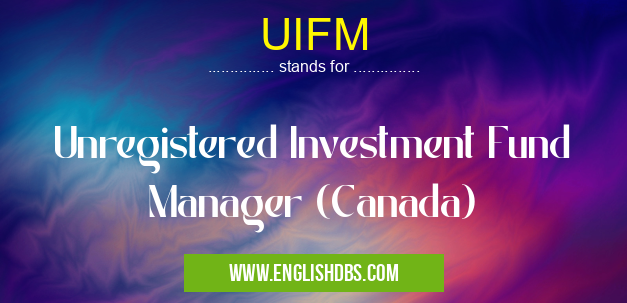What does UIFM mean in FUNDS
UIFM stands for Unregistered Investment Fund Manager. It refers to an individual or entity that manages investment funds in Canada but is not registered with the Canadian Securities Administrators (CSA).

UIFM meaning in Funds in Business
UIFM mostly used in an acronym Funds in Category Business that means Unregistered Investment Fund Manager (Canada)
Shorthand: UIFM,
Full Form: Unregistered Investment Fund Manager (Canada)
For more information of "Unregistered Investment Fund Manager (Canada)", see the section below.
Definition
UIFMs are not subject to the same regulatory requirements as registered investment fund managers. This means they have more flexibility in their investment strategies but also face greater scrutiny from investors. UIFMs are typically smaller in size and may specialize in niche markets or alternative investments.
Characteristics of UIFMs
- Unregistered: UIFMs are not registered with the CSA.
- Flexibility: They have more flexibility in their investment strategies compared to registered fund managers.
- Scrutiny: Investors must carefully evaluate UIFMs due to their lack of regulatory oversight.
- Specialization: UIFMs often specialize in specific investment areas or alternative asset classes.
- Risk: UIFM investments may carry higher risks than those managed by registered fund managers.
Advantages of UIFMs
- Tailored Investments: UIFMs can offer customized investment solutions based on specific investor needs.
- Potential for Higher Returns: They have the potential to generate higher returns due to their broader investment scope.
- Lower Fees: UIFMs may have lower management fees than registered fund managers.
Disadvantages of UIFMs
- Lack of Regulation: UIFMs are not subject to the same regulatory oversight as registered fund managers.
- Higher Risk: Investments managed by UIFMs may carry higher risks.
- Limited Track Record: UIFMs may have limited track records compared to registered fund managers.
- Investor Protections: Investors in UIFM funds may have fewer protections and remedies available.
Essential Questions and Answers on Unregistered Investment Fund Manager (Canada) in "BUSINESS»FUNDS"
What is an Unregistered Investment Fund Manager (UIFM)?
An UIFM is an investment manager who operates in Canada without registering with the provincial securities regulator. They may manage investment funds or portfolios for clients, but they are not subject to the same regulatory requirements as registered investment managers.
What are the advantages of investing with a UIFM?
Potential advantages include:
- Lower fees and expenses due to reduced regulatory compliance costs
- Greater flexibility and customization in investment strategies
- Access to potential investment opportunities not available through regulated funds
What are the risks of investing with a UIFM?
Potential risks include:
- Lack of regulatory oversight, which could increase the risk of fraud or mismanagement
- Limited investor protection and recourse in case of issues
- Potential tax implications as UIFMs may not be eligible for certain tax advantages
How do I know if an investment manager is an UIFM?
Look for the following indicators:
- The investment manager does not have a registration number with a provincial securities regulator
- The investment manager advertises or describes itself as an "unregistered investment fund manager"
- The investment manager's website or marketing materials state that it is not regulated by a securities regulator
Should I invest with an UIFM?
The decision depends on your individual circumstances and risk tolerance. Consider the potential advantages and risks carefully before investing. It is advisable to seek professional advice from a qualified financial advisor if you are unfamiliar with UIFMs.
Final Words: UIFMs play a niche role in the Canadian investment landscape. They offer investors potential flexibility and customization but also come with higher risks due to their lack of regulatory oversight. Investors considering UIFM investments should conduct thorough due diligence and understand the associated risks before making a decision.
